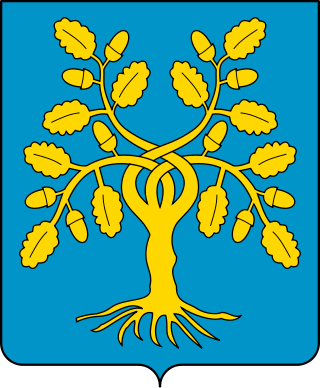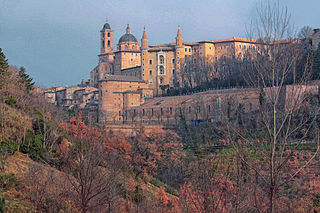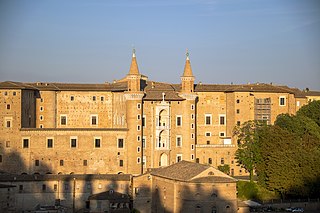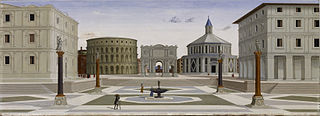
The House of Della Rovere was a powerful Italian noble family. It had humble origins in Savona, in Liguria, and acquired power and influence through nepotism and ambitious marriages arranged by two Della Rovere popes: Francesco Della Rovere, who ruled as Sixtus IV from 1471 to 1484 and his nephew Giuliano, who became Julius II in 1503. Sixtus IV built the Sistine Chapel, which was named after him. Julius II was patron to Michelangelo, Raphael and many other Renaissance artists and started the modern rebuilt of St. Peter's Basilica. Also the Basilica of San Pietro in Vincoli in Rome was the family church of the Della Rovere. Members of the family were influential in the Church of Rome, and as dukes of Urbino, dukes of Sora and lords of Senigallia; the title of Urbino was extinguished with the death of Francesco Maria II in 1631, and the family died out with the death of his granddaughter Vittoria, Grand Duchess of Tuscany.

Piero della Francesca was an Italian painter, mathematician and geometer of the Early Renaissance, nowadays chiefly appreciated for his art. His painting is characterized by its serene humanism, its use of geometric forms and perspective. His most famous work is the cycle of frescoes The History of the True Cross in the church of San Francesco in the Tuscan town of Arezzo.

Urbino is a comune (municipality) in the Italian region of Marche, southwest of Pesaro, a World Heritage Site notable for a remarkable historical legacy of independent Renaissance culture, especially under the patronage of Federico da Montefeltro, duke of Urbino from 1444 to 1482.

Federico da Montefeltro, also known as Federico III da Montefeltro KG, was one of the most successful mercenary captains (condottieri) of the Italian Renaissance, and lord of Urbino from 1444 until his death. A renowned intellectual humanist and civil leader in Urbino on top of his impeccable reputation for martial skill and honour, he commissioned the construction of a great library, perhaps the largest of Italy after the Vatican, with his own team of scribes in his scriptorium, and assembled around him a large humanistic court in the Ducal Palace, Urbino, designed by Luciano Laurana and Francesco di Giorgio Martini.

Girolamo Genga was an Italian painter and architect of the late Renaissance, Mannerist style.

Fossombrone is a town and comune in the province of Pesaro and Urbino, in the Marche region of central Italy.

The Ducal Palace is a Renaissance building in the Italian city of Urbino in the Marche. One of the most important monuments in Italy, it is listed as UNESCO World Heritage Site since 1998.

The Duchy of Urbino was an independent duchy in early modern central Italy, corresponding to the northern half of the modern region of Marche. It was directly annexed by the Papal States in 1631.

Francesco Maria I della Rovere was an Italian condottiero, who was Duke of Urbino from 1508 to 1516 and, after retaking the throne from Lorenzo II de' Medici, from 1521 to 1538.

Giovanni Santi was an Italian painter and decorator, father of Raphael. He was born in 1435 at Colbordolo in the Duchy of Urbino. He studied under Piero della Francesca and was influenced by Fiorenzo di Lorenzo. He was court painter to the Duke of Urbino and painted several altarpieces. He died in Urbino.

Oddantonio da Montefeltro was the first duke of Urbino in Italy.

The Brera Madonna is a painting by the Italian Renaissance master Piero della Francesca, executed in 1472–1474. It is housed in the Pinacoteca di Brera of Milan, where it was deposited by Napoleon.

Giovanni della Rovere was an Italian condottiero. He was a nephew of Pope Sixtus IV, and the brother of Giuliano della Rovere (1443–1513), Pope Julius II from 1503.

Livia della Rovere was an Italian noblewoman of the House of della Rovere and the last Duchess of Urbino (1599–1631).

The Flagellation of Christ is a painting by Piero della Francesca in the Galleria Nazionale delle Marche in Urbino, Italy. Called by one writer an "enigmatic little painting," the composition is complex and unusual, and its iconography has been the subject of widely differing theories. Kenneth Clark called The Flagellation "the greatest small painting in the world".
The Ideal City is the title given to three strikingly similar Italian Renaissance paintings of unresolved attribution. Being kept at three different places they are most commonly referred to by their location: The Ideal city of Urbino, Baltimore, and Berlin. Hubert Damisch, who has written at length about the paintings, refers to them as the "Urbino perspectives" or "panels". The three paintings are dated to the late 15th century and most probably they have different authors but various attributions have been advanced for each without any consensus. There is also a discussion about the purpose of the paintings as they are all in an unusual elongated format. In 2012 the Baltimore and Urbino panels were shown at a joint exhibition, with the Berlin painting being represented by a copy, as the original is too fragile to be shipped abroad.
Ventura Mazza or Mazzi or Marzi or Mazi or Magi was an Italian painter of the late-Renaissance.

Santa Maria delle Grazie is a 17th-century Baroque-style, Roman Catholic church and convent located just outside the city of Senigallia, region of Marche, Italy.

The Diptych of Federico da Montefeltro and Battista Sforza are two oil paintings by Italian artist Piero della Francesca, dated to 1473–1475. This famed double portrait is often mistitled The Duke and Duchess of Urbino—as it appears on the website of the Uffizi Gallery, which owns it. Since Battista Sforza died in 1472 and Federico da Montefeltro was not made duke until 1474, however, Battista never attained the title of duchess.

The Renaissance in Urbino was one of the most fundamental manifestations of the early Italian Renaissance.


















